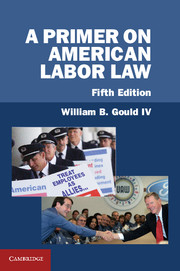Book contents
- Frontmatter
- Contents
- Preface to the Fifth Edition
- Preface to the Fourth Edition
- Preface to the Third Edition
- Preface to the Second Edition
- Preface to the First Edition
- 1 An Overview
- 2 Industrial Relations and Labor Law before Modern Legislation
- 3 The National Labor Relations Act and Related Labor Law
- 4 Unfair Labor Practices
- 5 Establishing the Collective Bargaining Relationship: Organization and Recognition
- 6 Economic Pressure and Bargaining Tactics in the Established Relationship
- 7 Remedies, the Labor Reform Bill of 1978, and the Employee Free Choice Bill of 2009
- 8 Dispute Resolution in the Established Relationship
- 9 The Duty of Fair Representation
- 10 The Public Sector
- 11 Public-Interest Labor Law
- 12 Conclusion
- Index
- References
8 - Dispute Resolution in the Established Relationship
Published online by Cambridge University Press: 05 June 2013
- Frontmatter
- Contents
- Preface to the Fifth Edition
- Preface to the Fourth Edition
- Preface to the Third Edition
- Preface to the Second Edition
- Preface to the First Edition
- 1 An Overview
- 2 Industrial Relations and Labor Law before Modern Legislation
- 3 The National Labor Relations Act and Related Labor Law
- 4 Unfair Labor Practices
- 5 Establishing the Collective Bargaining Relationship: Organization and Recognition
- 6 Economic Pressure and Bargaining Tactics in the Established Relationship
- 7 Remedies, the Labor Reform Bill of 1978, and the Employee Free Choice Bill of 2009
- 8 Dispute Resolution in the Established Relationship
- 9 The Duty of Fair Representation
- 10 The Public Sector
- 11 Public-Interest Labor Law
- 12 Conclusion
- Index
- References
Summary
Dispute-resolution machinery, whether it is devised by private parties or imposed by legislation, generally focuses on two quite different problems. The first relates to disputes that arise during the term of the collective bargaining agreement, usually involving its interpretation. These are called “rights” disputes; the question is what resolution should be made where the parties disagree as to the application or interpretation of the agreement. The second area is “interest” disputes, that is, disputes that arise over the terms of the new collective bargaining agreement (generally after the expiration of the old one). These disputes, frequently resolved under guidelines or criteria established by the parties or by legislation, generally concern wages and other economic issues that go right to the core of the bargaining relationship. The mode of dispute resolution can vary. In the United States we have generally utilized mediation, fact-finding, or arbitration. Mediation involves the intervention of a third party, appointed by labor and management or by government, whose role it is to attempt to get the parties to resolve their differences amicably. The mediator has no authority to do anything – even to make recommendations to the parties as to how the matter should be resolved. Mediators often play innovative and important roles in the resolution of disputes, although sometimes they simply carry coffee from the labor side to the management side. But the third party’s function is to clarify the issues, appeal to the parties’ reasoning processes by using the arts of persuasion, and (when specifically authorized by the parties) to make recommendations to them. The mediator must have the parties’ confidence. They must be able to entrust their secrets and confidences to the mediator, without fear that this information will be leaked to the other side. A skillful mediator is able to make use of such information in offering suggestions, structuring the dialogue, or formulating proposals.
- Type
- Chapter
- Information
- A Primer on American Labor Law , pp. 251 - 298Publisher: Cambridge University PressPrint publication year: 2013



